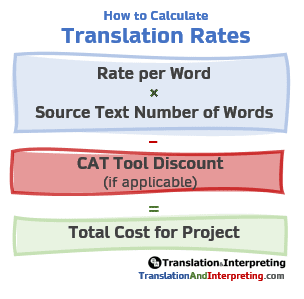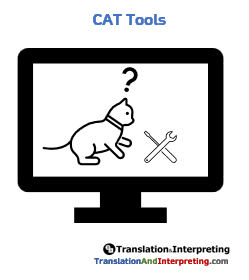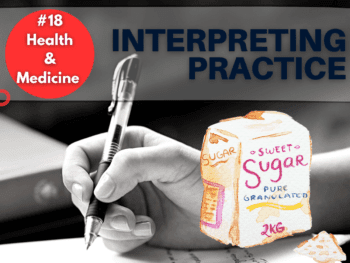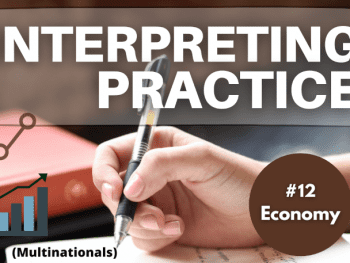What fees should freelance translators charge for their services? What are the average translation rates per word and what factors influence how much you can charge? Grab your calculator and let’s check the numbers!
Knowing how much to charge is a challenge many new freelance translators face when starting out. Indeed, the financial side of things is one of the most blatantly overlooked aspects of a translator’s training.
Many graduates are coming out of university with solid translation skills; nevertheless, they are left high and dry on an number of equally crucial aspects of the profession.
One of these overlooked aspects has to do with translation rates. Most newly-graduated translators don’t have the faintest idea of what their services are worth in the market, which is lamentable given how much students pay in university fees these days.
In this post I will attempt to shed some light on this topic, and hopefully help you gain a better understanding of how things work in the translation world. My perspective on the subject in that of a UK-based linguist, but the principles of translation pricing are essentially the same in most places.
As a ‘spoiler’, please note there isn’t a clear-cut answer: the average market rates depend on a number of factors. However, having a clearer knowledge of these factors should put you on the right track.
Click here if you just want to go straight to the average translation rates table without further ado.
How Translation Rates Are Calculated
Most professions run on an hourly pay basis: each hour of work equals to a fixed amount that is owed to you. In such cases, you trade each hour of your time for money.
In-house translators tend to get paid like this: they work for a company as employees, thus being included in the company’s payroll. It’s important to note, however, that in-house translators are rare to find these days, with most professional translators now working on a freelance basis.
Here things are very different: none of the ‘get-paid-by-the-hour’ logic applies to freelance translators. For most of us, the standard practice is to charge a rate per word. It’s the word count – not time – that matters. Let’s see how this works in more detail.
Translation Rates per Word
The principle is simple: to calculate how much you are to charge for a given translation project, you need to multiply your rate per word by the source text’s total number of words.
Example: Suppose you receive a 2,000-word document to translate. Suppose as well that you charge 10 pence per source text word. You need to multiply 2,000 words by 10p to get your cost estimate (2000 * 0.10). The result is £200.00 for this project.
In short, it doesn’t matter how much time the translator spends on a project. What really matters is the project’s volume in terms of the number of words.
Keep in mind this is just the principle. Calculating the total cost of a translation project can be a bit more nuanced and complicated nowadays. As you will see below, we are living in the CAT tool era. Repetition and fuzziness reports need to be taken into account too, and they play an important role when doing the math nowadays… but more on that in a second!

Note: Some translation agencies will ask for your translation rates per 1,000 words. It’s exactly the same thing as explained above, just formulated in a slightly different way: if you charge 10p per each single word, it follows that you charge £100 by 1,000 words.
What Rates Do Translators Charge Per Word
This is where it gets tricky, as there are many factors that influence a freelance translator’s rates.
Having worked as a Project Manager for several years with extensive cooperation with hundreds of other freelance translators, I’d say roughly there’s a fairly common range somewhere between 4p and 15p per word.
There’s a huge discrepancy between both ends of the aforementioned range, but my experience tells me this is essentially accurate. Most translation agencies perceive a 4p/word rate as cheap, while 15p/word is seen as expensive.
Important: If you have your own direct clients, you should be able to charge more than you normally would charge a translation agency. There’s no middleman in that case (you’re dealing with the end-client yourself), so you have more leeway to increase your rates in such cases.
New translators often charge too little for their services. That’s a huge mistake that usually ends up in the freelancer either having to fight back to raise the rates or just quit the industry altogether. It’s harder to convince a client to pay you more after they’ve benefited from your cheap services: they’ll always try to stand their ground and protect their advantageous position.

That’s why you should advertise your services with confidence and charge accordingly. Knowing exactly how much you can get away with will depend on a number of factors. Let’s dive into them!
Deciding Your Translation Rate per Word
The main factors that influence how much you will be able to charge as a freelance translator are:
- Your language combination(s)
- Your specialism(s)
- Your level of experience
Languages and Language Combinations
The first step to determine what values (rate per word) you can realistically ask for – and find customers willing to pay that – is to list your working languages, i.e., the language(s) you translate into and the language(s) you translate from.
Some languages are more expensive than others. It’s a result of a supply and demand curve.
Example: Translation rates for Nordic languages (such as Danish) tend to be considerably higher than those for Romance languages (such as Italian.) While the supply of professional linguists who work from/into Danish is low relative to the level of demand (which drives prices up), there’s a higher level of competition within the Italian language market (which drives prices down.)
To give you a clearer idea, I’ve listed some of the most common languages and divided them into groups* according to their average market rates (broadly speaking, as there may be exceptions to the rule.)
*Note: The below table is by no means ‘scientific’. It simply reflects my overall perception as someone who has been working as a PM for several years and has dealt with projects in all these languages. It’s been made to the best of my knowledge: if you feel anything is inaccurate kindly let me know in the comments. It’s also not ‘normative’ and just sums up the average market rates per language (it doesn’t mean there aren’t Italian linguists out there who charge higher translation rates than some Danish linguists, for instance.)
Language Groups | Examples |
Tier 1 Average Rates | Italian, Spanish, Portuguese, Romanian, Croatian, Serbian, Czech, Slovak, Polish, Bulgarian, Hungarian |
Tier 2 Above Average Rates | French, English, Russian, Ukrainian, Turkish, Greek, Vietnamese |
Tier 3 Costly Rates | Simplified Chinese, German, Dutch, Arabic, Hebrew |
Tier 4 Very Costly Rates | Japanese, Korean, Finnish, Danish, Swedish, Norwegian |
Most importantly, it’s the specific language combination (also known as language pair) that ultimately influences the average translation rates on the market. Again, it all comes down to supply and demand.
Example: The average rates of professionals who translate from Spanish into Italian tend to be lower than those of linguists who translate from Catalan into Italian. That’s because there are more professionals capable of doing the former than the latter.
Our friends from ProZ.com have been kind enough to make a translation rate search engine available to all of us. They have gathered the jobs carried out through their platform and calculated the average rates per word for each language combination. You can use this search engine by clicking the image below:

As stated, the results are just a statistical aggregate of projects carried out through their platform. It does not necessarily reflect at 100% what’s being done on the market as a whole, but it’s still an amazing way to get some sort of idea.
Specialism(s)
The above rate search engine also has a filter that allows you to search for a specific specialism (or field of expertise.) That’s another important factor that may influence your translation rates.
This one is self-explanatory: the more specialised the content, the more skill it requires to translate. A translator who specialises in, say, wind energy converters is in a better position to charge more for their services than a linguist who specialises in human resources.
For that reason, financially speaking, developing a high level of expertise in a selected number of technical fields is a wise decision, since it allows you to level up your game (and your rates.)
Experience
Finally, practice indeed makes perfect. A more experienced linguist tends to be able to charge higher rates for the same type of service than a newbie: their perceived value and trustworthiness makes it easier for clients to accept higher rates.

These are the main factors that influence translation rates per word. Nevertheless, as already briefly stated, it’s important to also keep in mind that nowadays, with the advent of CAT tools, the way project costs are calculated is a bit more complex.
That is something to keep in mind once you have decided your translation rates per word, as it affects how much you get paid per project. That’s what we’ll see next.
Repetitions, Matches and Fuzziness: How CAT Tools Affect Translation Fees
CAT tools are the real game changer in modern-day translation, for better or worse. They have introduced us to statistical analyses of source texts and inserted a degree of automation to the translation process.
Texts may sometimes be repetitive, with the same sentence appearing on more than one occasion. Other times, despite not being the exact same sentence, it may be highly similar to many other sentences throughout the file.
In addition, CAT tools use Translation Memories (TMs) to store previous translations. When analysing a new text against an existing TM, the exact same sentences (or very similar sentences) may show up more than once.
In short, a good CAT tool can deliver a statistical report in a matter of seconds on things such as:
- The level of repetition (i.e., how repetitive the text is)
- The level of homogeneity (i.e., internal similarities within a project)
- The level of fuzziness (i.e., similarities, or ‘matches’, between a new project and previous translations stored in an existing TM)

Nowadays, the total amount a translator is paid for per project is proportional to the statistics of the source text.
That’s because the combination of CAT tools with TMs helped speeding up the translation process. Back in the day, if the text was repetitive, the linguist still had to manually translate the exact same sentence(s) – or very similar ones – over and over from scratch; now, thanks to functionalities such as auto-propagation, pre-translation and quality assurance, the same thing can be done quickly, more consistently and with less effort.
Of course, there’s a downside to it. If parts of the content are repeated, very similar to one another, or have already been stored in the TM, you won’t get paid in full for those specific parts.
So, if a project has absolutely no reps or matches, you get paid 100% of your standard rate for every single word you are translating (in a CAT tool context these ‘unique’ words tend do be known as ‘New Words‘ or ‘No Match Words‘.)
On the other hand, if half of a project is made of ‘No Match Words’ and the other half has some degree of fuzziness and/or repetition, you get paid 100% of your rate per word on 50% of the project; for the other half of the text, a CAT tool discount will be applied against your rate per word.
Below is a screenshot of a statistics report from memoQ, which is one of the major CAT tools on the market. Note how the software runs the stats and splits the total word count into different categories/brackets depending on their level of repetition/fuzziness:

In the above example, the translator would get paid:
- the full rate per word on 136 words (which equates to the No Match bracket)
- a varying, gradual percentage of the standard rate per word on 237 words (which equates to the 4 fuzzy brackets: 95%-99%, 85%-94%, 75%-84% and 50%-74%)
- a tiny fraction (at best) of the standard rate per word on 70 words (which equates to the Repetition, 101% and 100% match brackets)
Note: Some clients/agencies are more generous than others when it comes to calculating CAT tool discounts – there really isn’t a universal rule for this. It’s always best to ask for a clarification with regard to this and decide for yourself whether their terms are agreeable.
Minimum Charges
It is also common practice for translators to set a minimum charge for their services.
Example: If you decide to set a translation minimum charge at £25.00, you are essentially stating you won’t accept being paid less than £25.00 per project – even if the project you’re being contacted for is tiny.
This is a way to encourage clients to contact you for projects with at least a somewhat meaningful volume, as opposed to sending you numerous tiny projects several times a day that individually may pay you close to nothing.
From a financial perspective, minimum charges are a wise decision to ensure there is value in the jobs you commit to.

I have seen minimum charges starting at £10.00 and going as far as £50.00. Again, it all comes down to supply and demand: translators who are constantly swamped with work may want to consider raising their minimum charge at some point; translators who are struggling to find work may have to lower it in order to become more competitive.
Important: Please note that not every client is willing to agree to a minimum charge these days, or they may want to negotiate a lower minimum charge with you. You need to see for yourself whether that makes financial sense given your specific circumstances. There’s nothing wrong with negotiating with clients if that works to your advantage!
Alternative Ways to Price a Translation
This word count-based method has been used on the UK market for a long a time, and eventually became the gold standard for pricing translation services. For that reason, it’s what makes sense on today’s market – most translation agencies and direct clients won’t accept any other method.
Do keep in mind, however, that despite being predominant, this method is not the only one in existence. A brief mention to other measures is probably worth it for ‘educational purposes’.
On the one hand, in some very specific cases it may still be possible to charge a translation hourly rate: it all depends on your agreement with your particular client. But realistically speaking, that’s not very common any more.
Depending on the language, there are some linguists who either charge by the number of target text words (instead of source text) or ask for the source text word count to be multiplied by, say, 1.1 or 1.2 in order to increase the total count.
Example: Linguists who translate from German tend to get a somewhat raw deal, considering that German is notorious for its tendency to compound words. One single word in German may sometimes equate to 3 or 4 words in English – but sadly the linguist only gets paid for 1.
Those linguists are mostly from a previous generation and are kind of swimming against the tide (which doesn’t mean they are wrong or their method doesn’t make sense: it’s the fiercely competitive translation industry as a whole that’s pushing things towards a different direction.)
In addition, ‘old school’ clients in some specific markets may still use a more ‘traditional’ measurement to calculate translation prices. Examples of that are the lauda in Brazil and the cartella in Italy, which are units of measurement that consider the number of lines and characters (not the number of words.) We don’t hear those terms as often these days, but they keep being used to an extend in some contexts.

Conclusion
Translation is a highly competitive industry, with many nuances and different factors that influence market rates. Applying a translation rate per word is the standard nowadays, both in the UK and in most of the world – although exceptions may take place.
The main factors you need to take into account are your language combination(s), your specialism(s) and experience.
When CAT tools are used, that is likely to result in some sort of reduction to the overall translation project fee you otherwise would be owed. However, CAT tools should most definitely speed up and simplify your tasks if used properly.
You should aim to set your translation fees at a price that makes sense to your skills and circumstances. Trying to undercut all your competitors always leads to a bad result: you’ll work like a mad person and still struggle to make ends meet. It’s always best to value your profession fairly and, most importantly, yourself.
If you’ve found this post helpful or think it could be useful to a friend who perhaps is – or is planning to become – a translator or interpreter, please kindly consider buying me a coffee by using the button below:
I put all my heart and soul into the content I produce in order to help my fellow linguists set foot in the industry. Most of what I do is available to everyone for free.
Donating is 100% optional, but greatly appreciated. A short espresso will do! ☕















 TextExpander: Productivity Software For Freelancers
TextExpander: Productivity Software For Freelancers
My name is David. Hello. Everyone will enjoy your translation blog, and I myself think it’s quite helpful. I also serve as a translator at Acadetudio. Acadestudio offers Czech translation, dubbing, voice-over, interpreting, transcribing, and other translation services. Please get in touch with Acadestudio.com if you need any language services.
Thanks a lot for this post, it’s hugely enlightening. I’ll owe you thousands of coffee till I get in the industry and start earning my own coffee
Thank you David! 🙂
Thank you for this really helpful post. One thing that it doesn’t cover is the proofreading part. As a starting freelance translator, I am confused as to whether I should factor/add this onto a quote or is it understood that the translator will do the proofreading and that’s already included in the rate per word. Also, in order to comply with certain European norms you are apparently supposed to get someone else to proofread other than yourself which would drastically reduce down your margin as a freelancer if you have to pay for this service. Any thoughts or input on this, or am I getting it all wrong?
Hi Myriam, translation and proofreading are separate services; according to most ISO standards, the proofreading part should always be done by a second linguist. That said, you should still always revise your own translation before delivering it (every good translator must do that to avoid delivering a text with errors), but normally that’s already included in your translation rates.
If you’re getting your projects from translation agencies, it’s their duty to hire a proof-reader – not yours. You were hired as a translator, so your task is to translate the files to the best of your ability. Someone else will be hired by the agency to do the proofreading, but that’s not your responsibility; you may just have to respond to any queries raised by the proof-reader, and sometimes you will be asked to do some amendments to the text (but not always).
Equally, sometimes you may also be hired to work as an actual proof-reader rather than translator, i.e., you’ll proofread the translation that was made by somebody else (this can be charged per word or by the hour); however, this is a service I stopped offering many years ago, as it just isn’t my thing.
Thank you for this post. I am approaching now the translation world as a freelance, but I have been translating all my life for the companies I worked for during the years. I am aware of the existence of CAT tools, but never used one professionally, Do you have any to suggest?
Also you write that if you use a CAT tool you get paid less. Who decide this?
Thank you for your answer
Hi Sonia! The CAT tool that I use is memoQ, but there are several others you can choose from (Trados, MemSource, etc). It all comes down to personal choice, really.
Regarding ‘being paid less’, I explain that with a lot of detail in this post: it has to do with source text repetition, matches and fuzziness.